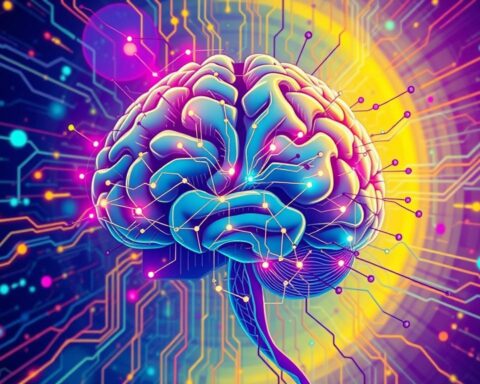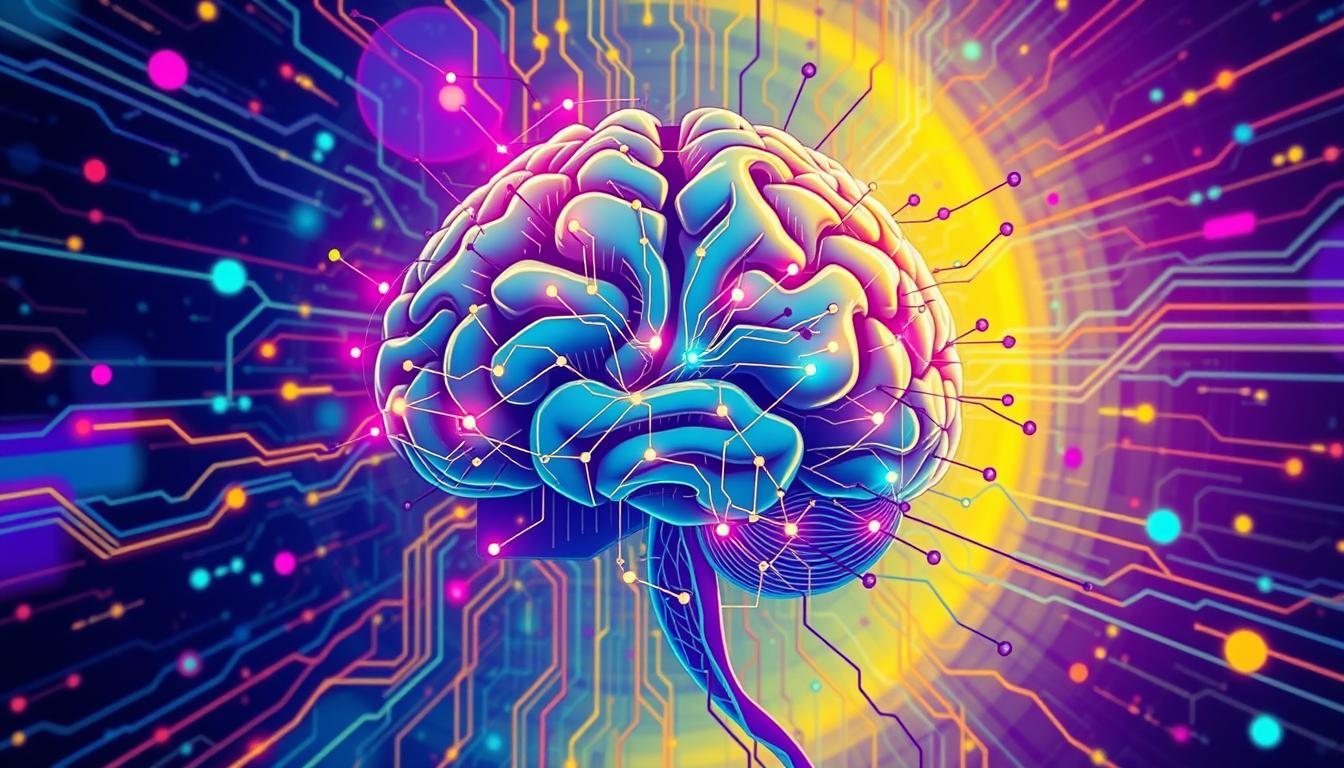Imagine a world where complex problems are solved step by step. Each step is carefully planned to find the best solution. This is what algorithmic thinking is all about. It has changed how we solve problems in many areas1.
It helps us break down big problems into smaller parts. We can then find patterns and create efficient solutions. These solutions can be used over and over again1.
At the core of algorithmic thinking is understanding how computers work. This skill is not just for computer science2. It teaches us to solve problems in a structured way. This improves our logical thinking and creativity2.
Learning algorithmic thinking lets us solve complex problems with confidence. It helps drive innovation and productivity in many fields and daily tasks.
Key Takeaways
- Algorithmic thinking is a problem-solving approach that emphasizes precision, efficiency, and the ability to handle complex problems through simplification.
- It involves breaking down problems into clear, logical steps and creating replicable processes or algorithms to arrive at effective solutions.
- Algorithmic thinking is derived from computer science and coding, but its principles are applicable across a wide range of disciplines and everyday tasks.
- Mastering algorithmic thinking enhances problem-solving abilities, logical reasoning, and creativity, making it a valuable skill set for individuals at all levels.
- Computational thinking, which includes decomposition, pattern recognition, abstraction, and algorithmic thinking, is a key component of effective problem-solving.
Understanding the Foundations of Algorithmic Thinking
Algorithmic thinking is key in solving problems and developing software. It breaks down complex issues into simple steps. This method is vital for developers, as algorithms are essential for efficient work3.
Developers often use algorithms when coding, in interviews, and daily tasks3.
Defining Core Problem-Solving Concepts
At the core of algorithmic thinking is defining problems clearly. It involves breaking them down into smaller parts and solving each part3. This structured approach is different from how we usually solve problems3.
Learning algorithmic thinking takes practice. It’s like learning to organize code into classes3.
Historical Evolution of Algorithmic Approaches
The roots of algorithmic thinking go back to the early 20th century. Mathematicians started formalizing problem-solving methods then4. Frank P. Ramsey used these principles to show the importance of order in math, leading to Ramsey Theory4.
This evolution marked a shift from intuitive to systematic problem-solving. It laid the groundwork for modern combinatorial theories4.
Key Components of Algorithmic Solutions
Algorithms are vital in computer programming, providing clear instructions for solving problems5. They help develop problem-solving and logical thinking skills, essential in today’s digital world5.
Efficient algorithms save time and memory, important for handling large data or real-time tasks5. Knowing algorithms is a base for learning about data structures, artificial intelligence, and machine learning5.
| Key Algorithmic Thinking Concepts | Description |
|---|---|
| Problem Decomposition | Breaking down complex problems into smaller, more manageable components |
| Step-by-Step Instructions | Defining clear and unambiguous steps to solve a problem |
| Optimization | Improving the efficiency of an algorithm in terms of time and space complexity |
| Abstraction | Identifying and representing the essential elements of a problem, ignoring unnecessary details |
| Pattern Recognition | Identifying recurring structures or sequences that can be generalized and reused |
Understanding algorithmic thinking helps develop problem-solving skills and logical thinking3. It prepares learners for a world driven by technology5.
Algorithmic Thinking, Algorithmic Thinking Concepts
Algorithmic thinking is all about solving problems in a smart way. It involves organizing data well, using resources wisely, and creating solutions that grow with needs6. This way of thinking is key for solving big problems in fields like data science and software engineering6. It helps people break down big problems into smaller steps, find patterns, and make solutions that can change with new needs6.
Over time, the basics of algorithmic thinking have changed a lot. Books like George Pólya’s “How to Solve It” have helped shape how we solve problems6. The “Conceptual Frameworks” book also helps in organizing thoughts and ideas, making problem-solving better6. As technology keeps changing fast, this way of solving problems is more important than ever. Customers want answers quickly and solutions that work well6.
Algorithmic thinking also looks at how fast and how much space a solution needs6. Choosing the right algorithm can make a big difference in how well a solution works6. Mixing different ways of solving problems can also lead to new ideas and better solutions6.
Algorithmic thinking is also taught in schools, from early education to university7. It helps students understand computer science better, like how to make sure a solution works and is efficient7. This new way of teaching algorithms is helping prepare people for the future, where thinking algorithmically is key7.
Places like HackerRank, LeetCode, and CodeWars offer chances to practice solving problems6. These sites help people get better at thinking algorithmically, which is important for real-world problems6.
As algorithmic thinking becomes more important, schools and online learning sites are creating special courses8. For example, Rice University has “Algorithmic Thinking” courses with great reviews and lots of students8. These courses teach advanced techniques, like how to solve problems by breaking them down and using dynamic programming8.
In short, algorithmic thinking is essential today because of fast technology changes and new customer needs6. By learning to solve problems in a systematic way, people can tackle big challenges. This leads to new ideas and progress in many areas6.
Breaking Down Complex Problems into Manageable Steps
Dealing with complex problems can feel overwhelming. But, with the right strategies, it becomes easier. The first step is to break down the problem into smaller parts. This is called problem decomposition9. It’s a method used by experts, who often use whiteboards to plan their solutions9.
Problem Decomposition Techniques
Problem decomposition means finding the main parts of a problem and splitting it into smaller ones. This helps you understand what you need to do to solve it9. By breaking down big problems, you can solve them step by step and really get to know the issue10.
Pattern Recognition Strategies
Pattern recognition is also key in solving problems. It helps you spot common themes and use first principles thinking to find better solutions9. This method, favored by people like Elon Musk, helps you start with the basics and build up9.
Solution Design Methods
Once you’ve broken down the problem and seen patterns, it’s time to design a solution. You need to make a clear plan or algorithm to fix the problem. It’s also important to test and improve this solution to make sure it works well9. By being flexible and willing to try again, you can create strong solutions for many different situations10.
Algorithmic thinking helps you solve big problems by breaking them down and finding patterns. By doing this, you can create strong solutions for real-world problems10.
The Role of Data Structures in Algorithmic Problem Solving
Algorithms and data structures are key in computer science. They are vital for programming and software development11. Knowing them helps programmers write better code and make reliable software11.
Mastering these concepts makes work more efficient. It also saves resources and improves job interviews11.
Learning about data structures and algorithms (DSA) boosts problem-solving skills. It makes coding faster and easier. It also helps in learning new things and getting ahead in your career12.
DSA knowledge lets designers make systems that grow and stay stable. This ensures systems work well and reliably11.
Algorithms are everywhere in our lives. They shape who we are and how we make choices13. But, using data structures and algorithms can be tricky. Knowing why and how to solve these problems is key for good programming11.
| Significance of Learning Data Structures and Algorithms (DSA) |
|---|
|
In today’s tech world, thinking like an algorithm is key. It’s about solving problems with logical steps12. Employers often care more about how you solve problems than the solution itself in interviews12.
Developing algorithmic thinking can impress employers. It also improves problem-solving skills among programmers12.
Algorithmic puzzles and real-life uses, like caching and sorting, show how to solve problems efficiently12. By understanding problems well and choosing the right approach, programmers can solve problems better and make reliable software12.
Implementing Pattern Recognition and Abstraction
Algorithmic thinking is key to solving problems. It helps us spot patterns and create simple models for solving problems14. This method has become popular, thanks to J. M. Wing’s 2006 essay in Communications of the ACM14. S. Papert also talked about it 10 years earlier at MIT14.
Identifying Common Patterns
Spotting patterns is vital in algorithmic thinking. It lets us find common structures in problems. This way, we can solve problems more efficiently and use our solutions over and over14. It makes solving problems easier and more scalable14.
Creating Abstract Models
Abstraction is another important part of algorithmic thinking. It means simplifying problems to their core elements14. This helps us focus on what really matters and makes solving problems more manageable.
Applying Reusable Solutions
By finding patterns and making simple models, we can create solutions that work for many problems14. This saves time and makes solving problems more efficient. It’s very useful in today’s fast-changing world14.
| Computational Thinking Skills | Percentage of Lessons |
|---|---|
| Algorithmic Thinking | 25% |
| Decomposition | 20% |
| Abstraction | 18% |
| Pattern Recognition | 17% |
The most important skills in lesson plans are algorithmic thinking (25%), decomposition (20%), abstraction (18%), and pattern recognition (17%)15. These skills are key to solving problems and creating reusable solutions15.
“Computational thinking can be a universal skill, applicable across many disciplines. It enables us to break down complex problems, recognize patterns, and develop solutions in a systematic and scalable manner.”
The quote shows how pattern recognition, abstraction, and creating reusable solutions are at the heart of algorithmic thinking. These skills help us solve problems in many areas16.
Developing Efficient Solution Strategies
Algorithmic thinking is now a big deal in programming. It’s all about breaking down problems into clear steps17. First, you need to understand the problem. This means knowing what data you need, what you’re trying to get out, and how you’ll do it17.
Choosing the right concepts is key. You should think about what you already know, known algorithms, and how to handle data17. Using data structures like arrays and loops can make things simpler17.
Creating an algorithm strategy involves solving examples and generalizing steps17. You might use divide and conquer or dynamic programming to solve problems17. Checking if your solution works means analyzing it step by step and looking at how efficient it is17.
Solving puzzles can improve your problem-solving skills17. Puzzles like the Monty Hall problem and the Tower of Hanoi teach different strategies17.
In computer science, there are many problem-solving strategies17. You can build solutions step by step or solve smaller problems first17. There’s also the greedy approach, where you make choices that seem good at the time to get the best result17.
Algorithmic thinking is a key skill in computer science education18. It can be tough for students to grasp, but it’s very important18. Getting more people interested in computer science is important because algorithms are powerful tools18.
Learning algorithms can involve a lot of students18. It’s about analyzing problems, finding basic actions, and making sure your algorithm works for all cases18. This skill includes abstract thinking, creativity, and problem-solving18.
Starting out with algorithmic thinking can be hard because it’s complex18. To make it easier, use everyday tasks and simple language for algorithms18. Beginners learn better by understanding the principles and solving new problems themselves18.
Teachers play a big role in helping students learn18. Written algorithms might be hard for beginners, but playing algorithms can help them learn the basics18. There are different ways to play algorithms, each with its own benefits18.

Creating efficient solutions is a big part of algorithmic thinking17. By understanding the basics and how algorithms have evolved, you can make solutions that work well and use resources wisely17.
| Problem-Solving Strategy | Description |
|---|---|
| Incremental Approach | Building a solution step by step |
| Decrease and Conquer | Solving subproblems and combining them |
| Divide and Conquer | Solving multiple subproblems efficiently |
| Transform and Conquer | Simplifying a problem through instance simplification, representation change, or problem reduction |
| Greedy Approach | Making locally optimal choices at each step to achieve a globally optimal solution |
“Algorithmic thinking is considered to be one of the main abilities that pupils may achieve in informatics education at school and university level.”18
Testing and Debugging Algorithmic Solutions
Creating efficient algorithms is key in computer science. But, it’s just the start. Testing and debugging are vital to make sure algorithms work well19.
Verification Methods
Checking if an algorithm is correct is the first step. It’s about making test cases for all kinds of inputs. This makes sure the algorithm always gives the right answers20.
Common Testing Approaches
- Unit testing: Checking each part of the algorithm to see if it works right.
- Integration testing: Seeing how all parts of the algorithm work together.
- Stress testing: Testing the algorithm with lots of data to find its limits.
Optimization Techniques
After testing and fixing, we focus on making it better. We look for slow parts, make the logic smoother, and use better data structures20.
By using a detailed approach to testing and debugging, developers can make sure their algorithms are strong. They will be reliable and fast1920.
Real-World Applications of Algorithmic Thinking
Algorithmic thinking is now a key skill in many fields and our daily lives. It helps improve tests in schools and makes online experiences better. This way, we interact with technology in new ways21.
In schools, tests are now on computers and change based on how well you do21. This helps teachers see how much you’ve learned and teach you better. Also, coding classes, like those at Learning.com, teach students to solve problems21.
Online, algorithms shape what we see every day. Google’s search results, for example, are sorted by how many sites link to them21. With so many websites, finding what you need quickly is key. Algorithmic thinking makes this possible21.
| Application | Algorithmic Impact | Key Statistics |
|---|---|---|
| Public Transportation | Algorithms help optimize bus schedules and routes to improve efficiency and reliability. | 34 million Americans rely on public transportation daily22. |
| Navigation and Travel | Algorithms power location-tracking apps and GPS systems, enabling seamless navigation and travel planning. | 15 million Americans regularly allow their location to be tracked through apps22. |
| Music Streaming | Algorithms analyze user preferences and listening habits to recommend personalized music content, enriching user experience. | Spotify has 200 million premium subscribers globally, with algorithms driving around 90% of its revenue22. |
| Search Engines | Algorithms determine search result rankings, directing users to the most relevant and valuable information. | There are 5.4 billion Google searches per day, making its algorithms critical for user discovery22. |
| Social Media | Algorithms curate news feeds, suggest content, and drive targeted advertising to improve user engagement and revenue. | Facebook has over 1.9 billion daily users, with its algorithms generating $6.87 in average ad revenue per user22. |
| E-commerce | Algorithms analyze customer behavior and preferences to offer personalized recommendations and optimize sales. | 80% of Americans shopped for groceries online during the pandemic, contributing to $1.137 trillion in e-commerce sales22. Smaller e-commerce sites can earn up to $150,000 in three months using algorithms, while larger platforms like Amazon can earn $280.5 billion22. |
These examples show how algorithmic thinking is used in many areas. It makes learning better and helps create new digital ideas. By learning about algorithms, we can solve many problems and find new opportunities2122.
“Algorithmic thinking encourages students to enhance critical thinking, communication skills, problem-solving abilities, and adapt to uncertainty and ambiguity.”21
Conclusion
Algorithmic thinking is a key problem-solving method in today’s tech world. It helps us break down big issues into smaller, manageable steps. This way, we can improve our problem-solving skills in both our personal and work lives23.
A study in Turkey showed how important teachers are in teaching algorithmic thinking. Students said that teachers who think this way make learning better. They create organized classrooms that help students solve problems in a structured way23.
There are many ways to teach algorithmic thinking, like discovery learning and case studies. These methods can be used in school to help students get better at solving problems23.
The importance of algorithmic thinking will grow as the world changes. It’s useful in STEM fields and even in robotics. Being able to solve problems in a structured way will be more valuable23.
By learning to solve problems in a step-by-step way, we prepare ourselves for the future. We become ready to face complex challenges with confidence and skill23.
FAQ
What is algorithmic thinking?
Algorithmic thinking is a way to solve problems by breaking them down into simple steps. It focuses on being precise and efficient. It helps tackle complex problems by making them simpler.
What are the foundations of algorithmic thinking?
The basics of algorithmic thinking include breaking down problems into parts and understanding how to solve them. It covers everything from basic computer concepts to advanced algorithms. It’s all about structured thinking in programming and software development.
What are the core concepts of algorithmic thinking?
At its core, algorithmic thinking is about solving problems in a systematic way. It involves organizing data, using resources wisely, and designing solutions that can grow. It’s all about using logic and a structured approach to solve big problems.
How do you break down complex problems into manageable steps?
Algorithmic thinking uses special techniques to make big problems smaller. It helps find patterns, create solution plans, and solve problems step by step.
What is the role of data structures in algorithmic problem-solving?
Data structures help organize and store information well, which affects how fast and efficient a program is. Algorithmic thinking looks into how to organize and work with data.
How do you implement pattern recognition and abstraction in algorithmic thinking?
Algorithmic thinking is about finding common patterns in problems and creating general models for solving them. This way, you can use the same solutions over and over again.
What is the importance of developing efficient solution strategies?
Algorithmic thinking is all about finding the best solutions by planning and executing them well. It shows how important it is to be efficient when designing and running algorithms.
How do you test and debug algorithmic solutions?
Algorithmic thinking teaches how to test and fix solutions thoroughly. It includes checking solutions and making them better for performance.
What are the real-world applications of algorithmic thinking?
Algorithmic thinking has many uses in real life, from making software to solving everyday problems. It shows how it works in different areas, like business and technology.
Source Links
- Definitions of Computational Thinking, Algorithmic Thinking & Design Thinking – https://www.learning.com/blog/defining-computational-algorithmic-design-thinking/
- Computational and Algorithmic Thinking by Georgios Tsatiris on Maven – https://maven.com/gtsatiris/computational-thinking
- Algorithmic Thinking: How to Master This Essential Skill – https://learntocodewith.me/posts/algorithmic-thinking/
- Algorithmic thinking – (Ramsey Theory) – Vocab, Definition, Explanations | Fiveable – https://fiveable.me/key-terms/ramsey-theory/algorithmic-thinking
- Teaching Students About Algorithms in Computer Programming | Learning.com – https://www.learning.com/blog/teaching-algorithms/
- Algorithmic Thinking for Data Scientists – https://towardsdatascience.com/algorithmic-thinking-for-data-scientists-4601ac68496f
- Algorithmic Thinking: The Key for Understanding Computer Science – https://link.springer.com/chapter/10.1007/11915355_15
- Algorithmic Thinking (Part 2) – https://www.coursera.org/learn/algorithmic-thinking-2
- Algorithmic Thinking: The Art of solving complex Problems – https://medium.com/wayra-germany/algorithmic-thinking-the-art-of-solving-complex-problems-2747756c823
- What is Computational Thinking, and how do you teach it? – https://www.pi-top.com/blog/essentialtoolsforcsandsteam-0-0
- Mastering Algorithms and Data Structures: Key to Enhancing Problem-Solving Skills and Algorithmic… – https://medium.com/@mahdiehmortazavi/mastering-algorithms-and-data-structures-key-to-enhancing-problem-solving-skills-and-algorithmic-d77377f61a75
- How to Improve Algorithmic Thinking Skills in DSA? – https://www.enjoyalgorithms.com/blog/how-to-develop-algorithmic-thinking-in-data-structure-and-algorithms/
- Best Algorithmic Thinking Courses Online with Certificates [2024] | Coursera – https://www.coursera.org/courses?query=algorithmic thinking
- Computational Thinking Definition | Learning.com – https://www.learning.com/blog/defining-computational-thinking/
- Computational Thinking Lessons – https://ctlessons.org/
- Launching Computational Thinking Routines for K-5 ELA – Digital Promise – https://digitalpromise.org/2024/08/29/launching-computational-thinking-routines-for-k-5-ela/
- How to Develop Algorithmic Thinking in Computer Science? – https://medium.com/enjoy-algorithm/how-to-develop-algorithmic-thinking-in-data-structure-and-algorithms-b000bbad1ab5
- Microsoft Word – PaperFutschekMoschitz.doc – https://publik.tuwien.ac.at/files/PubDat_187461.pdf
- Algorithmic Thinking – https://teachinglondoncomputing.org/resources/developing-computational-thinking/algorithmic-thinking/
- 15-112: Fundamentals of Programming – http://www.krivers.net/15112-s19/notes/notes-algorithmic-thinking.html
- Algorithmic Thinking Examples in Everyday Life | Learning.com – https://www.learning.com/blog/examples-of-algorithmic-thinking/
- 10 Algorithm Examples in Everyday Life – https://www.invisibly.com/learn-blog/algorithm-examples-everyday-life/
- PDF – https://ijpe.inased.org/makale_indir/1587










